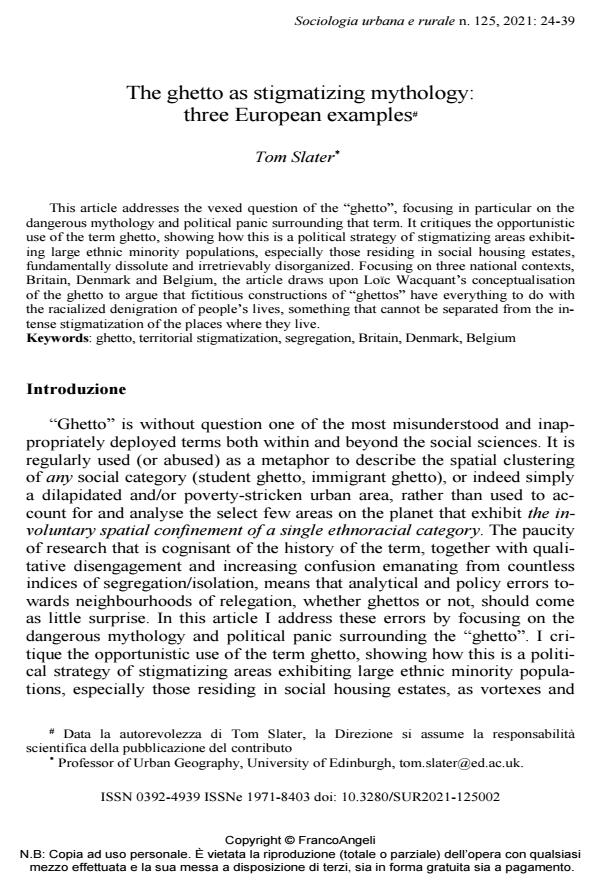The ghetto as stigmatizing mythology: three European examples
Titolo Rivista SOCIOLOGIA URBANA E RURALE
Autori/Curatori Tom Slater
Anno di pubblicazione 2021 Fascicolo 2021/125
Lingua Italiano Numero pagine 16 P. 24-39 Dimensione file 302 KB
DOI 10.3280/SUR2021-125002
Il DOI è il codice a barre della proprietà intellettuale: per saperne di più
clicca qui
Qui sotto puoi vedere in anteprima la prima pagina di questo articolo.
Se questo articolo ti interessa, lo puoi acquistare (e scaricare in formato pdf) seguendo le facili indicazioni per acquistare il download credit. Acquista Download Credits per scaricare questo Articolo in formato PDF

FrancoAngeli è membro della Publishers International Linking Association, Inc (PILA)associazione indipendente e non profit per facilitare (attraverso i servizi tecnologici implementati da CrossRef.org) l’accesso degli studiosi ai contenuti digitali nelle pubblicazioni professionali e scientifiche
Questo articolo affronta l'annosa questione del "ghetto", soffermandosi in particolare sulla pericolosa mitologia e sul panico politico che circonda il termine. A partire dall'uso opportunistico del termine ghetto, si mostra come questo sia una strategia politica di stigmatizzazione di aree in cui vivono in gran parte le minoranze etniche, in particolare quelle che risiedono in complessi di edilizia popolare, fondamentalmente dissoluti e irrimediabilmente disorganizzati. Concentrandosi su tre contesti nazionali, Gran Bretagna, Danimarca e Belgio, l'articolo attinge alla concettualizzazione del ghetto di Loïc Wacquant per sostenere che le costruzioni fittizie di "ghetti" hanno tutto a che fare con la denigrazione razziale della vita delle persone che non può essere separato dalla intensa stigmatizzazione dei luoghi in cui vivono.;
Keywords:ghetto, stigmatizzazione territoriale, segregazione, Gran Bretagna, Danimarca, Belgio.
- Chalmers R. (2017). Is Molenbeek Really a No-Go Zone? GQ Magazine, 21st June.
- Cohen R. (2016). The Islamic State of Molenbeek. New York Times, 16th April.
- Finney N., Simpson L. (2009). Sleepwalking to Segregation: Challenging Myths About Race and Migration. Bristol: Policy Press.
- Hoffmann-Schroeder A.S. (2019). Young Women Fight the Government’s Ghetto List. Deutsche Welle (DW), 30th December. Text available here: https://www.dw.com/en/denmark-young-women-fight-the-governments-ghetto-list/a-51833223.
- Johnston R., Forrest J., Poulsen M. (2002). Are There Ethnic Enclaves/Ghettos in English Cities? Urban Studies, 39 (4): 591-618. DOI: 10.1080/00420980220119480
- Johnston R., Poulsen M., Forrest J. (2005). On the Measurement and Meaning of Residential Segregation: A Response to Simpson. Urban Studies, 42(7): 1221-1227. DOI: 10.1080/00420980500122010
- Johnston R., Poulsen M., Forrest J. (2010). Moving On From Indices, Refocusing on Mix: On Measuring and Understanding Ethnic Patterns of Residential Segregation. Journal of Ethnic and Migration Studies, 36(4): 697-706. DOI: 10.1080/13691830903505045
- Jones D. (2015). Europe’s Crucible of Terror. The Daily Mail, 16th November.
- Kundnani A. (2001). From Oldham to Bradford: the Violence of the Violated. Race and Class, 43(2): 105-31.
- Lapeyronnie D. (2007). Ghetto Urbain: Segregation, Violence, Pauvrete en France aujourd’hui. Paris: Robert Laffont.
- Peach C. (1996). Does Britain have Ghettos? Transactions of the Institute of British Geographers, 21(1): 216-235. DOI: 10.2307/622934
- Peach C. (2009). Slippery Segregation: Discovering or Manufacturing Ghettos? Journal of Ethnic and Migration Studies, 35(9): 1381-1395. DOI: 10.1080/13691830903125885
- Peach C., Byron M. (1994). Council House Sales, Residualisation and Afro-Caribbean Tenants. Journal of Social Policy, 23(3): 363-383. DOI: 10.1017/S0047279400021905
- Phillips T. (2005). After 7/7: Sleepwalking to Segregation. Speech delivered at Manchester Town Hall, 22nd September.
- Philpott T.L. (1978). The Slum and the Ghetto: Neighbourhood Deterioration and Middle-Class Reform, Chicago 1880-1930. New York: Oxford University Press. Poulsen M. (2005). The ‘New Geography’ of Ethnicity in Britain. Unpublished paper delivered to the Annual Conference of the Royal Geographical Society-Institute of British Geographers, 31st August.
- Poulsen M., Johnston R. (2006). Ethnic Residential Segregation in England: Getting the Right Message Across. Environment and Planning A, 38: 2195-2199.
- Sennett R. (1994). Flesh and Stone: The Body and the City in Western Civilization. London: Fa-ber & Faber.
- Simpson L. (2007). Ghettos of the Mind: the Empirical Behaviour of Indices of Segregation and Diversity. Journal of the Royal Statistical Society, 170(2): 405-424.
- Slater T., Anderson N. (2012). The Reputational Ghetto: Territorial Stigmatisation in St. Paul’s, Bristol. Transactions of the Institute of British Geographers, 37(4): 530-546.
- Traynor I. (2015). Molenbeek: The Brussels Borough Becoming Known as Europe’s Jihadi Cen-tral. The Guardian, 15th November.
- Wacquant L. (2004). Ghetto. In Smelser N., Baltes P. (eds.). International Encyclopedia of the Social and Behavioural Sciences. London: Pergamon Press.
- Wacquant L. (2008a). Ghettos and Anti-Ghettos: an Anatomy of the New Urban Poverty. Thesis Eleven, 94: 113-118. DOI: 10.1177/0725513608093280
- Wacquant L. (2008b). Urban Outcasts: A Comparative Sociology of Advanced Marginality. Cambridge: Polity Press.
- Wacquant L. (2010). Urban Desolation and Symbolic Denigration in the Hyperghetto. Social Psychology Quarterly, 73(3): 215-219. DOI: 10.1177/0190272510377880
- Wacquant L. (2012). A Janus-faced Institution of Ethnoracial Closure: A Sociological Specifica-tion of the Ghetto. In Hutchison R., Haynes B. (eds.). The Ghetto: Contemporary Global Is-sues and Controversies. Boulder, CA: Westview Press.
Tom Slater, The ghetto as stigmatizing mythology: three European examples in "SOCIOLOGIA URBANA E RURALE" 125/2021, pp 24-39, DOI: 10.3280/SUR2021-125002